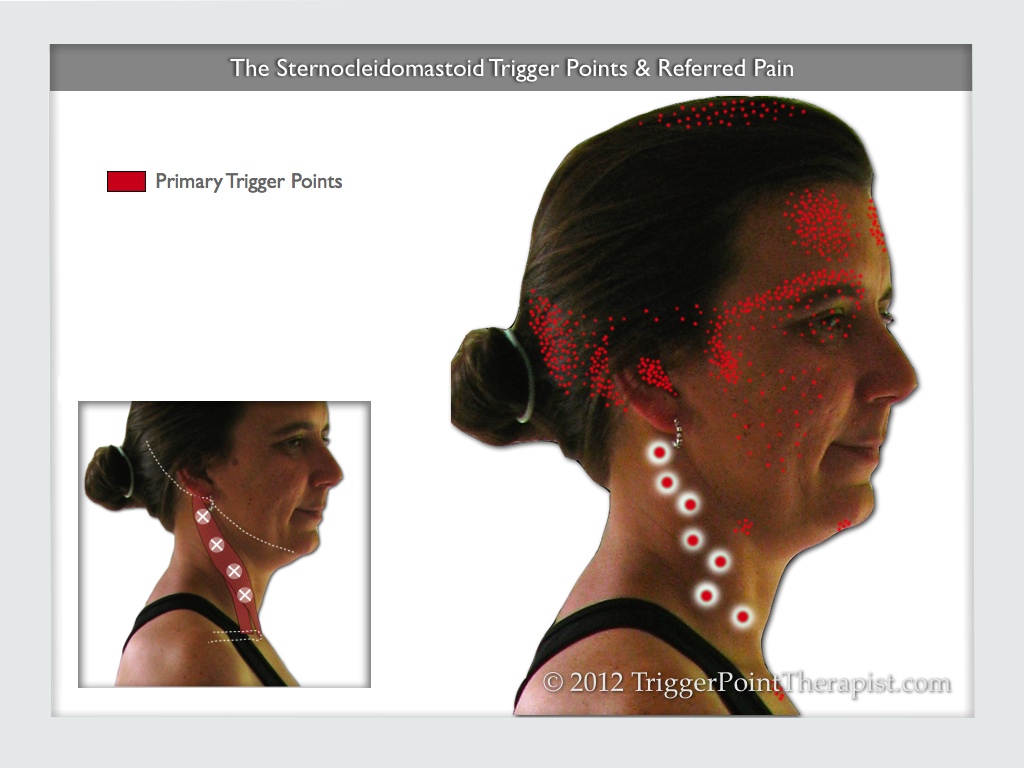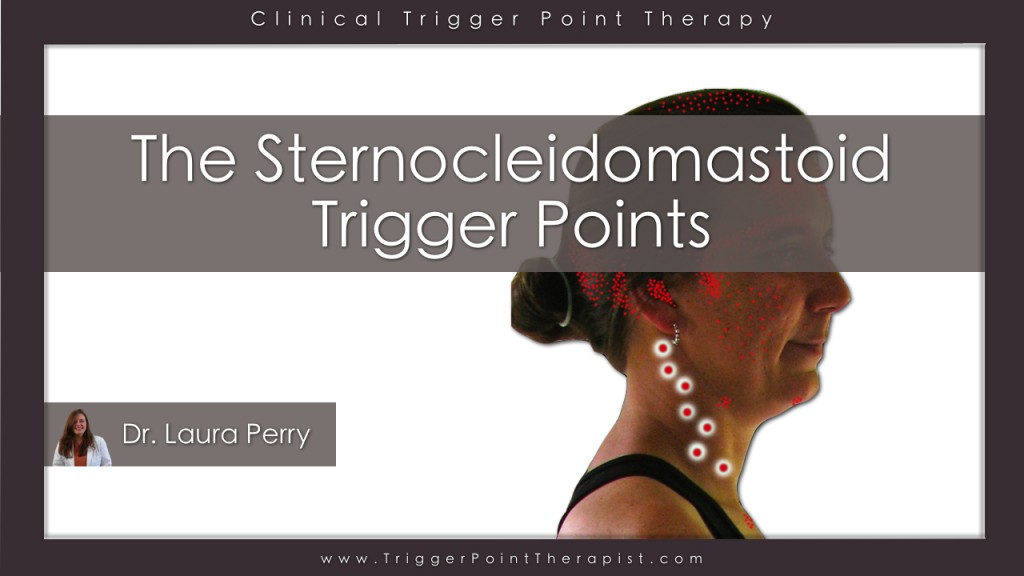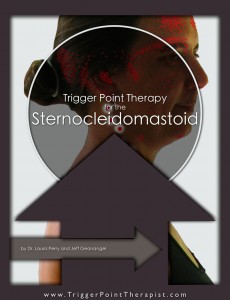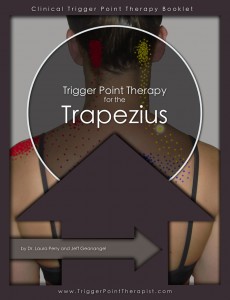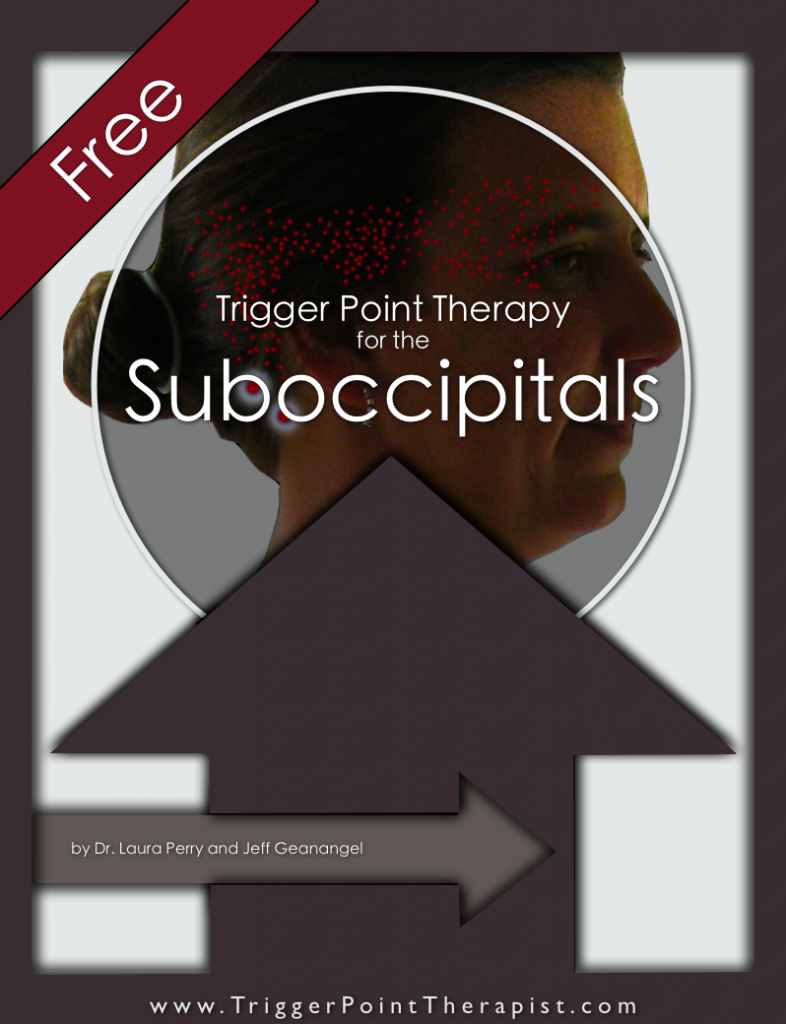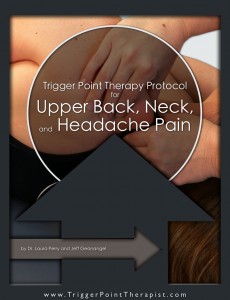The sternocleidomastoid (SCM) is one of my favorite muscle groups to work with, mainly because the results can be simply extraordinary. Trigger point activity in this muscle can cause a bewilderingly set of symptoms, with many being confusingly similar to the symptoms associated with the common (no aura) migraine headache.
Make no mistake, these are the “go-to” trigger points when a client presents with any type of headache pain, but they can also produce such diverse symptoms as a dry cough, sore throat, sinus pain, excessive eye tearing, visual disturbances, fainting, and dizziness / vertigo.
The Sternocleidomastoid Muscle Group
Please see the excerpt from the Trigger Point Therapy for Sternocleidomastoid Video Download for the basic anatomical and biomechanical details of this remarkable muscle group. Listed below are some of the highlights:
Anatomical Highlights:
- Each SCM group has two divisions that originate off the mastoid process behind the ear. The sternal division runs diagonally downward to attach to the sternum, while the clavicular division attaches right behind it on the medial clavicle.
- Acting unilaterally, contraction of the SCM muscle turns the head towards the opposite side, while bilateral contraction flexes the neck and head forward.
- The most important function of the SCM is to control and monitor the head’s position in space. Proprioceptive feedback from the SCM is essential to being able to maintain one’s balance, and is also important for interpreting visual information.
- A secondary function of the SCM is to assist inhalation by lifting the rib cage.
Biomechanical Highlights:
- The SCM muscles work synergistically with the trapezius and scalene muscles during lateral flexion of the neck, and with the scalene muscles during forced inhalation.
- The trapezius muscle is antagonistic during forward neck flexion.
The Sternocleidomastoid Trigger Points
The SCM muscle group can contain a whopping seven trigger points, making it’s trigger point density one of the highest in the body. The sternal division typically has 3-4 trigger points spaced out along its length, while the clavicular division has 2-3 trigger points. Usually, both divisions have simultaneous trigger point activity, but on occasion, I’ll have a client with trigger points only in the sternal division. Trigger points typically develop in one SCM muscle group first, but quickly spread to the SCM on the opposite side of the neck.
Sternocleidomastoid Pain
Each SCM division has a separate and distinct referred pain pattern:
- The sternal division’s referred pain is felt deep in the eye socket (behind the eye), above the eye, in the cheek region, around the temporomandibular joint (TMJ), in the upper chest, in the back of the head, and on the top of the head.
- The clavicular division’s referred pain is felt in the forehead, deep in the ear, behind the ear, and in the molar teeth on the same side. The really strange thing about this pain presentation is that the forehead pain may extend across the midline of the forehead to the other side.
Sternocleidomastoid Symptoms & Disorders
The SCM trigger points are unique in that they can produce a copious amount of symptoms that appear to have nothing to do with the musculoskeletal system. Listed below are some of symptoms and disorders that can be produced by these trigger points:
- Tension Headache: A common, but debilitating, headache that is typically attributed to perceived muscle tension in the neck and cranial muscles. The duration of these headaches can vary from 30 minutes to several days, and may occur daily in chronic cases.
- Migraine Headache: The SCM trigger points can produce many of the symptoms associated with non-aura migraine headaches, such as visual disturbances, muscle tenderness, and unilateral (one-sided) headache pain.
- Hangover Headache: The dehydration caused by excessive alcohol intake can activate trigger points in the SCM and trapezius muscles and produce the dreaded “hangover” headache.
- Atypical Facial Neuralgia: Pain in the cheek, jaw, and temple regions.
- Sore throat and Pain on Swallowing: The middle trigger point in the sternal division can produce pain at the base of the tongue that makes it difficult and/or painful to swallow.
- Visual Disturbances: Trigger points in the sternal division commonly produce blurred vision, double vision, and a dimming of perceived light intensity.
- Eye Problems such as a drooping eye-lid (ptosis), excessive eye tearing and/or reddening of one or both eyes.
- Forehead Sweating: sweating on one side of the forehead, above the eye.
- Dizziness & Vertigo: Dizziness when moving the head, such as lifting it to turn over in bed, or when tilting it backward to look at something above. Seasickness or car sickness are typically a problem, and quick movements of the head may cause fainting and/or nausea.
- Hearing Impairment: Trigger points in the clavicular division may cause moderate deafness or “ringing” in one ear.
- Sore Neck: While the SCM trigger points don’t refer pain to the neck, clients with these trigger points will often rub their necks to alleviate soreness in the region.
- Upper Chest Pain: The lower trigger point in the sternal division may refer pain to the upper chest bone region.
What Causes Sternocleidomastoid Trigger Points?
In my clinical experience, trigger points in the SCM muscles are frequently caused by trigger point activity in the trapezius muscle, particularly if the trapezius trigger points are left untreated for an extended period. Both muscle groups can be overloaded by similar physical and behavioral stressors, which include:
- Whiplash from a car accident can put extraordinary stress on the SCM muscles as they contract to control the violent backward movement of the head.
- Working Overhead: Activities that require one to look upwardly for long periods of time, such as painting a ceiling, can overstretch the SCM muscles.
- Forward-Head Posture: The all-too-common forward-head, slumped-shoulder postural distortion keeps the SCM muscles in an unnaturally shortened position, making them prone to developing trigger points.
- Sleeping Position: Sleeping with the head flexed forward because the pillow is to big (or using two pillows), or with the head turned, can put strain on these muscles.
- Chronic Cough: The SCM can be overloaded by repeatedly lifting the chest and ribcage during inhalation while coughing.
- Tight Collar: Physical pressure from a tight neck-tie or collar may irritate SCM trigger points.
- Limping: Limping on one leg for extended periods may overload the SCM as it tries to compensate for a leaning trunk and keep the eyes level.
Treatment of SCM Trigger Points
Locating and releasing these trigger points is complicated by their proximity to many blood vessels and nerves in the neck region. Because of this, the application of direct pressure is limited to the superior trigger point only, with the rest of the trigger points released with a specific squeezing-type of technique.
For complete details on the release procedure that I use for the SCM trigger points in my clinical practice, you can purchasing the Trigger Point Therapy for Sternocleidomastoid Video Download or the Trigger Point Therapy for the Sternocleidomastoid Booklet for the iPad.
Click on the image below to watch an excerpt from the Sternocleidomastoid Trigger Points video on YouTube:
Related Articles:
Related Instructional Videos:
